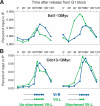Increased association of telomerase with short telomeres in yeast
- PMID: 17639079
- PMCID: PMC1920167
- DOI: 10.1101/gad.438907
Increased association of telomerase with short telomeres in yeast
Abstract
Telomere function is mediated by the assembly of a protein complex on an array of telomeric DNA (TG) repeats synthesized by the telomerase enzyme. Telomerase action at chromosome ends is finely tuned by the telomeric complex so that a constant average number of repeats is maintained. This is achieved through a negative feedback process that is sensitive to TG tract length, but whose underlying mechanism is unknown. We show that short telomeres, which are preferential substrates for telomerase, display increased association with the enzyme in the S phase of the cell cycle, when telomerase acts. In addition, we provide support for a molecular mechanism by which this key step of telomerase recruitment is regulated by TG tract length.
Figures





References
-
- Autexier C., Lue N.F., Lue N.F. The structure and function of telomerase reverse transcriptase. Annu. Rev. Biochem. 2006;75:493–517. - PubMed
-
- Bertuch A.A., Lundblad V., Lundblad V. The maintenance and masking of chromosome termini. Curr. Opin. Cell Biol. 2006;18:247–253. - PubMed
-
- Bianchi A., Shore D., Shore D. Early replication of short telomeres in budding yeast. Cell. 2007;128:1051–1062. - PubMed
-
- Bianchi A., Negrini S., Shore D., Negrini S., Shore D., Shore D. Delivery of yeast telomerase to a DNA break depends on the recruitment functions of cdc13 and est1. Mol. Cell. 2004;16:139–146. - PubMed
Publication types
MeSH terms
Substances
LinkOut - more resources
Full Text Sources
Molecular Biology Databases
Miscellaneous
